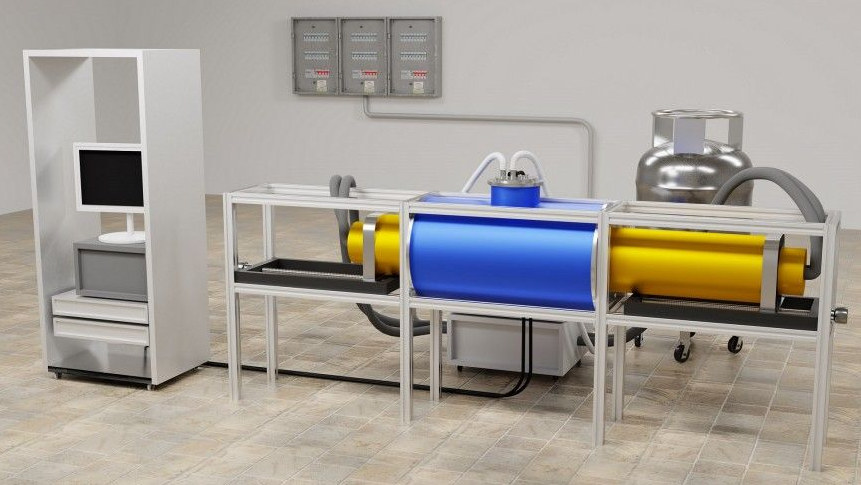During liquefaction, approximately a third of the energy content of hydrogen is lost, which makes the process largely uneconomical. In the Horizon Europe project HyLICAL with a budget of about some five million euros, a team including the Helmholtz-Zentrum Dresden-Rossendorf (HZDR), TU Darmstadt and the start-up MAGNOTHERM wants to significantly improve the technologies for storing liquid hydrogen. To this end, the team is building on magnetocaloric materials that change their temperature when they are exposed to a magnetic field.
Magnetocaloric effect: breaking out of its niche
“We want to establish a different liquefaction technology based on the principle of magnetic cooling. If we compare it figuratively with the conventional cooling process, a magnet would take on the role of the compressor and the magnetocaloric material would be the cooling agent. Together they allow us to achieve the low temperatures that are required for hydrogen liquefaction,” says Prof. Oliver Gutfleisch of the Institute of Materials Science at TU Darmstadt, outlining the idea underlying the project.
"Our technology means a huge increase in efficiency and sustainability to accelerate the green transformation"
Following many years of joint preliminary work, the company MAGNOTHERM, a TU Darmstadt spin-off. The start-up’s main aim is to launch magnetic cooling onto the market. One commercial product already exists: a drinks cooler for industrial applications. “Our technology also means a huge increase in efficiency and sustainability, completely free of compressors and environmentally harmful cooling gases. We can thus accelerate the green transformation,” explains Timur Sirman, one of MAGNOTHERM’s managing directors. HyLICAL is now the next step on the path to low-temperature applications.
The goal: five tons of liquid hydrogen – per day
The researchers now want to construct a prototype that will help to introduce magnetic cooling into industrial hydrogen liquefaction. In this context, the team can draw on HLD’s long-established expertise both in developing and manufacturing magnetic coils as well as in cryotechnology. “We have already investigated many magnetic materials in high fields – this materials library is a treasure trove of experience on which we can build,” says Gottschall, one of the founders of MAGNOTHERM. At TU Darmstadt, scientists are already developing magnetocaloric materials which function in the targeted temperature range. “To liquefy hydrogen, we need a temperature of minus 253 degrees Celsius. To get near these very low temperatures we pre-cool using liquid nitrogen which takes us to minus 196 degrees. Our magnetocaloric material then has to do the rest,” explains Gutfleisch.
The pilot plant is supposed to demonstrate that industrial-scale hydrogen liquefaction can be carried out using the magnetocaloric principle, which in concrete terms means producing more than five tons every day. Moreover, the researchers want to cut back the use of critical raw materials. By utilizing liquefaction, they are expecting to reduce energy consumption by up to 50 percent in comparison with the conventionally established technology. This should all serve to make liquid hydrogen much cheaper. In addition, the concept has scope for implementing liquefaction plants that can operate locally on a small scale. By operating this way, the technology also becomes interesting for expanding renewable energy sources. As it is frequently generated locally, this energy could thus be temporarily and advantageously stored via the detour of liquid hydrogen.
The project is supported by the Clean Hydrogen Partnership and its members. Funded by the European Union.
10 April 2023
Magnetocaloric effect for more efficient hydrogen liquefaction
Related news
Trane Technologies acquires Gradius
Trane Technologies has acquired the Gradius Business of Equans NV, a longstanding dealer of Thermo King and Frigoblock in Belgium and Luxembourg. The acquisition became effective on June 1, 2...
05 Jun 2025
CCR unveils new brand identity after separation from Carrier
CCR Commercial Refrigeration, formerly known as Carrier Commercial Refrigeration, has introduced a new brand identity following its acquisition by Haier. The rebranding includes a refreshed logo, u...
06 Jun 2025
Embraco to begin compressor production in India from 2026
Embraco, part of Nidec Global Appliance, has announced it will begin manufacturing compressors in India with a new facility in Chhatrapati Sambhaji Nagar (Aurangabad), Maharashtra. The plant is sch...
05 Jun 2025
Leonardo Cozac assumes ABRAVA presidency for 2025–2028 term
The new ABRAVA 360 board has officially taken leadership of the Brazilian Association of Refrigeration, Air Conditioning, Ventilation and Heating (ABRAVA) for the 2025–2028 term. The inaugurati...
12 Jun 2025
France selects CAP PAC 2030 project to support heat pump sector skills
AFPAC has welcomed the selection of the CAP PAC 2030 project, led by the Campus des Métiers et Qualifications d’Excellence (CMQ) Énergie Durable, under the "Compétences et Métiers d’Avenir" call fo...
15 Jun 2025
Chemours Appoints Nathan Blom to Lead Liquid Cooling Growth Portfolio
Chemours has named Nathan Blom as Vice President of its liquid cooling portfolio, effective June 9, 2025. The appointment supports the company’s strategy to expand in the liquid cooling market, vie...
10 Jun 2025
